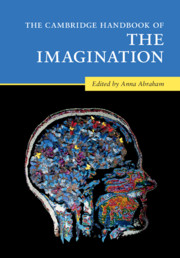Book contents
- The Cambridge Handbook of the Imagination
- The Cambridge Handbook of the Imagination
- Copyright page
- Dedication
- Contents
- Figures
- Contributors
- Acknowledgments
- 1 Surveying the Imagination Landscape
- Part I Theoretical Perspectives on the Imagination
- Part II Imagery-Based Forms of the Imagination
- Part III Intentionality-Based Forms of the Imagination
- Part IV Novel Combinatorial Forms of the Imagination
- Part V Phenomenology-Based Forms of the Imagination
- 34 Imagination in the Philosophy of Art
- 35 Imagination in Aesthetic Experience
- 36 The Arts and Human Symbolic Cognition: Art is for Social Communication
- 37 Aesthetic Engagement: Lessons from Art History, Neuroscience, and Society
- 38 Dance and the Imagination: Be a Butterfly!
- 39 Imagination, Intersubjectivity, and a Musical Therapeutic Process: A Personal Narrative
- Part VI Altered States of the Imagination
- Name Index
- Subject Index
- References
36 - The Arts and Human Symbolic Cognition: Art is for Social Communication
from Part V - Phenomenology-Based Forms of the Imagination
Published online by Cambridge University Press: 26 May 2020
- The Cambridge Handbook of the Imagination
- The Cambridge Handbook of the Imagination
- Copyright page
- Dedication
- Contents
- Figures
- Contributors
- Acknowledgments
- 1 Surveying the Imagination Landscape
- Part I Theoretical Perspectives on the Imagination
- Part II Imagery-Based Forms of the Imagination
- Part III Intentionality-Based Forms of the Imagination
- Part IV Novel Combinatorial Forms of the Imagination
- Part V Phenomenology-Based Forms of the Imagination
- 34 Imagination in the Philosophy of Art
- 35 Imagination in Aesthetic Experience
- 36 The Arts and Human Symbolic Cognition: Art is for Social Communication
- 37 Aesthetic Engagement: Lessons from Art History, Neuroscience, and Society
- 38 Dance and the Imagination: Be a Butterfly!
- 39 Imagination, Intersubjectivity, and a Musical Therapeutic Process: A Personal Narrative
- Part VI Altered States of the Imagination
- Name Index
- Subject Index
- References
Summary
Artistic expressions convey ideas, emotions, and norms, and reflect talent, skill, and capability to which the audience resonates. Both artist and viewer participate in art’s communication whose underlying cognitive bases are symbolic and abstract, not unlike language’s underpinnings in this regard. Exploring the distant evolutionary times of our genus, Homo sapiens, provides clues into why and how the arts emerged. I argue that originally they held utilitarian value for survival of small social groups, communicating messages of symbolic identity and cohesion. The communicative nature of art, and its acceptance into cultural practices, explains why it is when language abilities degrade following brain injury in nonartists, some resort to expressing themselves through paintings and drawings. These formats have been socially accepted forms of expression in the cultures in which these nonartists lived; they did not invent or create alternative cultural expressions. Similarly, established professional artists with brain injury, regardless of etiology or hemispheric laterality of injury, continue to produce their art without obvious or serious alterations to their talent, skills, or creativity. Such outcomes support observations that art’s communication system lacks localized, specialized brain regions, unlike language in this regard, and renders it a flexible system of communicating experiences, thoughts, emotions, imagination, and talents, skills, and creativity.
Keywords
- Type
- Chapter
- Information
- The Cambridge Handbook of the Imagination , pp. 593 - 607Publisher: Cambridge University PressPrint publication year: 2020

